One of the most significant factors in a home’s curb appeal is the state of its lawn. A meticulously paved driveway and gorgeous floral garden are only appealing when they have lush green grass to match. On the unfortunate occasion that your grass stops growing or worse, starts to die off, your property’s appearance and value also go downhill.
The truth is that your grass needs diligent caretaking, just like any outdoor garden or indoor houseplant collection. When you unknowingly don’t follow the right procedures for watering, fertilizing, or general care, you will have issues taking care of this expansive plant. You should also keep in mind that some of these dilemmas may be out of your control. The landscape, climate, and other environmental factors impact grass growth in a way that the typical homeowner may not foresee.
Luckily, if you catch many of these problems early, you can reverse the damage and return your grass to a healthy, flourishing state. Below are nine potential reasons your grass isn’t growing the way you expected and how you can solve these problems.
You need to change your watering habits or sprinkler system
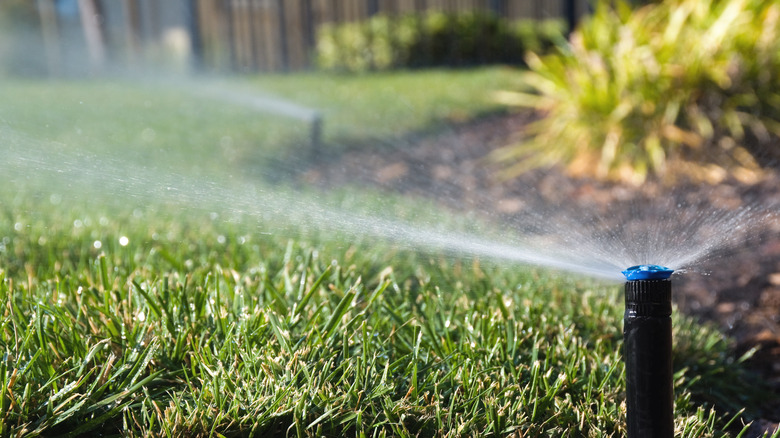
When plants stop growing, most people first think that they must be watering wrong. It’s common knowledge that plants need a certain amount of water for nourishment to complete photosynthesis and survive. If you fail to water your lawn correctly, your landscape will lose its lush green and become a wilted brown that cannot grow any further.
Luckily, water habits can be changed, whether you nurture your lawn with a hose or through an intricate sprinkler system. Most lawns need about 1 to 1.5 inches of water once or twice per week. However, the timing of these waterings is key. This should be done in the early morning before the sun is too high in the sky. This gives the grass time to soak in the water, but only for a short time before sunlight and heat evaporate excess moisture.
If your lawn has a sprinkler system, and you’re worried your system is over or under-watering, you should invest in a flow timer. This device measures the water flow to ensure the correct amount is being dispersed around your lawn every morning. Beware that you will need to do a bit of math to figure out how many gallons of water your grass needs. According to Scotts, you should multiply the total square footage of grass turf on your property by 0.62. The number you end up with is the recommended number of gallons you should be supplying your lawn per week.
The grass isn’t getting proper sunlight
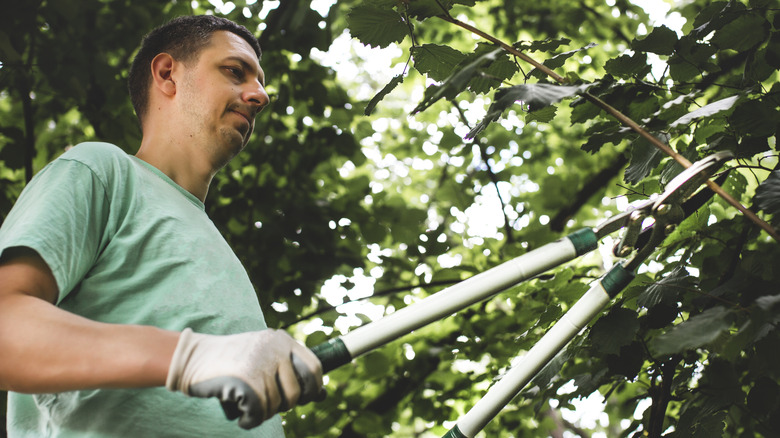
The second most well-known culprit behind poor-growing grass is a lack of or excess of sunlight. Many factors determine how much sunlight your yard gets, and most of it is completely out of your control. Depending on the time of year, time of day, geographic location, local climate, and topography of where you live, the sun may be too harsh or too shaded. In the United States, the midwest and southern states tend to get more sun, while northern states see less sunlight per year. However, even if you live in a sunnier area, your property might be blocked by overbearing trees and buildings, which can inhibit your lawn’s daily sustenance.
As a general rule, grass needs about four to six hours of sunlight per day to thrive. When grass doesn’t get those recommended hours, you may need to make some changes around your property. Sometimes the issue is that you have many large trees and shrubs scattered around your landscape, and you must prune them to allow more sunlight to filter through.
If the shade is due to your landscape or surrounding buildings, you may need to change up your water and mowing practices. Water less frequently since shaded grass uses less sunlight to photosynthesize, and less moisture evaporates throughout the day. You should also let shaded grass grow about ½ to 1 inch higher than sunlit areas so it has more surface space to absorb available light.
The soil is too alkaline or acidic
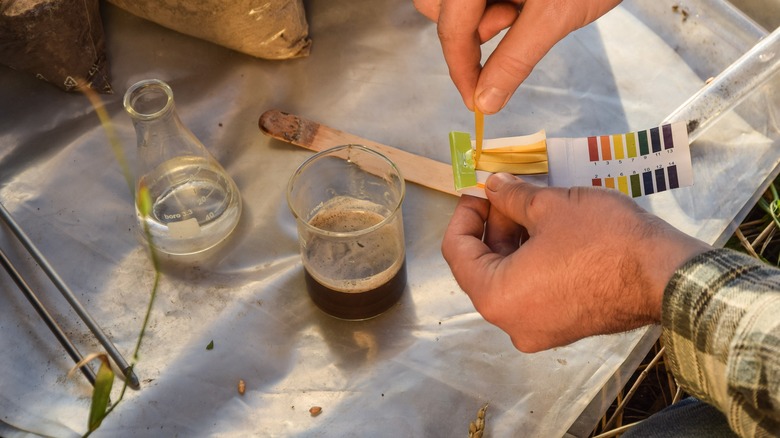
AlDa.team/Shutterstock
Delving into more scientific concepts can help you better understand why your grass isn’t growing as it should. Get a kit and measure the pH level of your soil, which is a number that indicates how many minerals are present. This number can fall anywhere between 0 and 14, and most grass species flourish in levels between 5 and 7.5. When the pH dips below 5, it is considered acidic. This usually occurs due to excess amounts of nitrogen, which comes from plant debris, fertilizer, and water runoff. Numbers above 7.5 indicate alkaline soil, which tends to be an issue in dry areas with little rainfall.
If your soil is at either end of the spectrum, you can make changes to directly influence the numbers. However, be warned that it’s easier to make the soil more acidic than it is to make it more alkaline. You can acidify the ground by adding products like sulfur, vinegar, and diluted lemon juice. Keep in mind the previous warning: be careful not to overdo it or be too aggressive. Lowering the acidity by adding compost, specific fertilizers, baking soda, and powdered limestone can take up to a year to take effect.
You or a previous homeowner planted the wrong type of seed
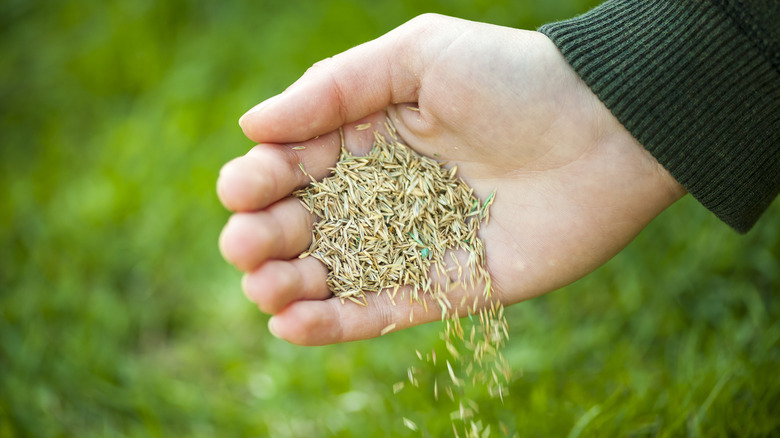
Elenathewise/Getty Images
Many people are under the assumption that grass is just grass. Despite how simple this plant appears, the term “grass” actually refers to over 12,000 species in the Poaceae or Gramineae family. Out of these thousands of species, only around ten of them are commonly used in lawns. Certain species thrive better in different geographical areas and climates, and most grass types are divided by warm and cold climates, making it easier for homeowners to choose a turf that will thrive on their property. To identify your current grass and determine if you should replace it with a more compatible species, you can study its characteristics, such as its texture, shape, and color. You can use Get Lawn Star’s grass identification guide or upload a photo of your lawn on Plantin for an AI-generated result.
If the grass type isn’t suited for your area, it’s time to browse for better options. Cold climates are fitting for Fine and Tall fescues, Kentucky bluegrass, and Perennial ryegrass. In contrast, Bahia, Bermuda, Zoysia, and St. Augustine grasses are better for warm-season locations.
You’re mowing too much or not enough
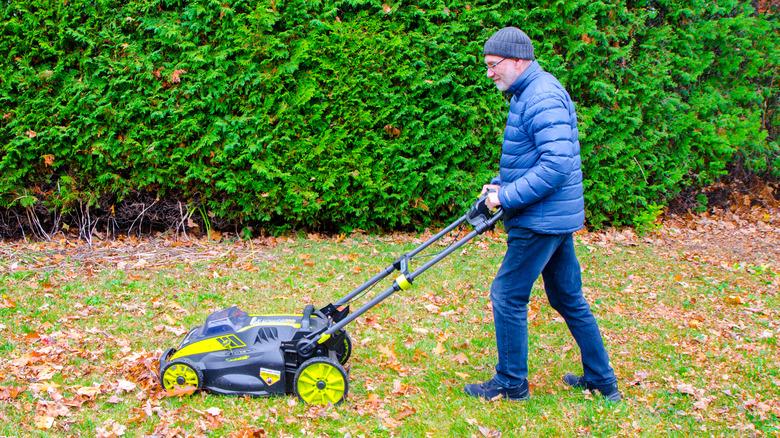
Marc Dufresne/Getty Images
Mowing your lawn on a fixed timespan isn’t just a chore to appease your neighborhood HOA. When done right, this routine keeps your entire lawn at a healthy length where all blades of grass can get the sunlight and nutrients they need. It’s a bit of an art form, and you must be careful not to overdo it or neglect your grass, both of which can impede growth and lead to other issues, like insect infestations and fungal diseases.
Before you even begin trimming your grass, make sure your mower blades are sharpened. Dull blades leave ragged cuts that make grass vulnerable to infection. You should avoid mowing during times of extreme weather, such as during a drought or after a severe rainstorm. Remember that pruning any plant puts stress on them, at least temporarily, and too much shock can damage their health. Trimming grass when it’s already in a weakened state is just asking a disease to make its move. If you determine the timing right, you should never shave off more than ⅓ of your grass’s height and most species should be kept between 0.5 and 4.5 inches tall.
The soil is too compact and needs to breathe
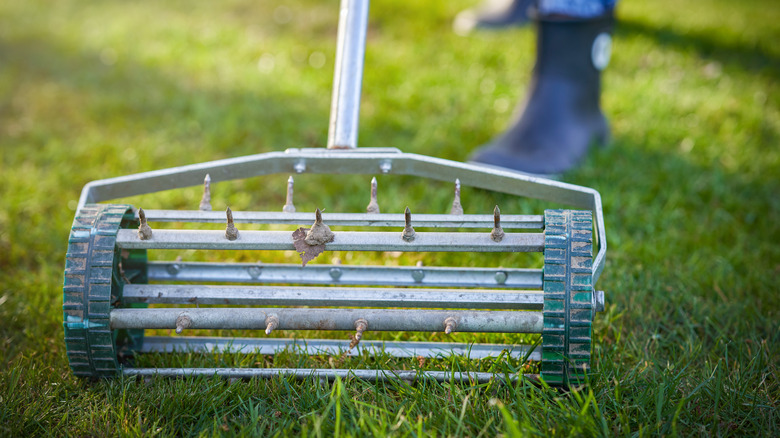
Macniak/Getty Images
The term “soil aeration” sounds more complex than it is. No matter how large or small your property is, sometimes the soil needs to be broken up to make it more breathable. Aeration loosens the earth, oxidizing the soil and making it easier for roots to push through and absorb surrounding nutrients. When soil is too compact, patches of your lawn turn an unsightly yellow or brown, and various weed species begin their aggressive takeover.
However, since grass yellows due to many reasons, you should look for additional signs of overly compacted soil. If you kneel down and pat your lawn, it may feel hard to the touch, and you may notice rainwater forms puddles instead of soaking into the surface. You should also attempt penetrating the ground with a wooden stake or metal tool. If it’s difficult to insert the item into the ground, your soil is too compact.
You can take the traditional approach to soil aeration by purchasing or renting electrical and mechanical lawn aerators at a local home improvement store. However, there are also liquid solutions on the market. These can be sprayed evenly across your yard to provide the same effect.
The soil has an improper balance of nitrogen, phosphorus, and potassium
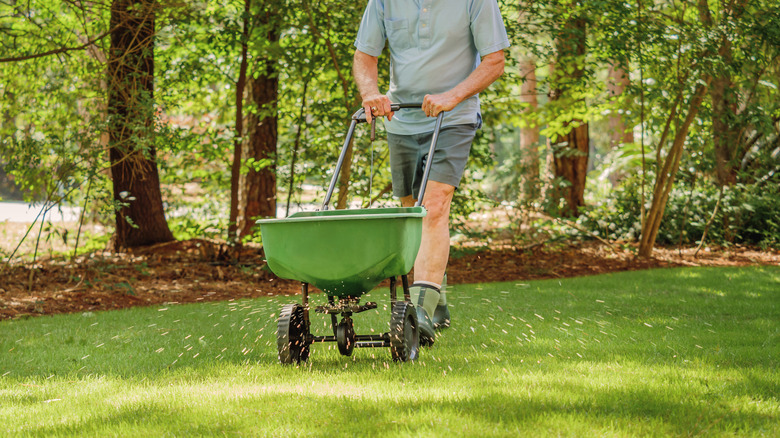
The Toidi/Shutterstock
Like all living things, grass won’t thrive and grow if it doesn’t have the proper nutrients to do so. The three main minerals it needs are nitrogen, phosphorous, and potassium, which are identified by their atomic numbers: N, P, and K, respectively. Each mineral plays a different role in keeping your lawn healthy. Nitrogen helps grass (and other plants) create chlorophyll, a necessary pigment for harnessing the sun’s energy. Phosphorous assists plant cells in transferring energy, and potassium supports photosynthesis, respiration, and other essential processes. When there is a deficiency in any of these categories, grass struggles to grow and becomes vulnerable to diseases that diminish its livelihood.
Applying fertilizer to nourish grass is a well-known practice that you can hire most professional landscapers for or undertake yourself. In fact, this process goes hand-in-hand with adjusting your soil’s pH levels. When tests reveal that your grass is low in certain minerals, you should apply a fertilizer with higher concentrations in those areas.
You should use a slow-release fertilizer, as one application deploys nutrients throughout your lawn over the course of six to eight weeks. The slow but steady release of minerals requires only two to three applications a year, and it is less likely to overwhelm the root systems with minerals. In case you aren’t aware, overdoing the fertilizer can have a reverse effect and cause harm by drying out your turf. Keep in mind that most liquid types are quick-release, while granular fertilizers and compost are usually slow-release.
A lawn disease runs rampant
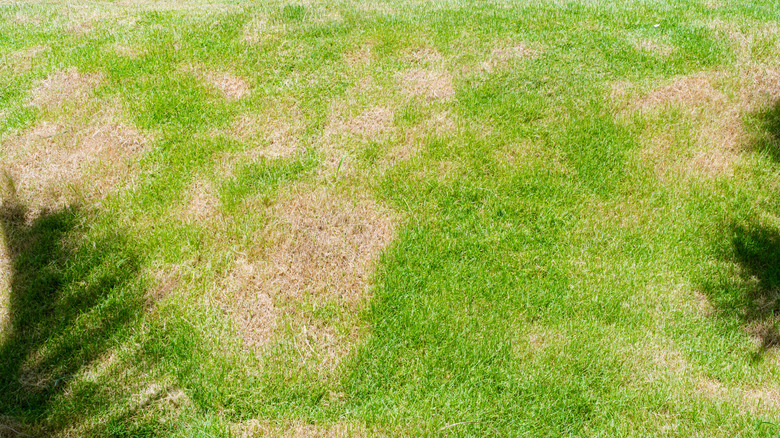
Singjai20/Getty Images
People, animals, and plants fall victim to diseases, and grass is no exception. Any of the issues above can lead to weakened root systems and leaves, making grass susceptible to various diseases. These afflictions are usually due to fungal growths, which cause discoloration, wilting, and eventually put a lawn in a state beyond repair. If it’s been over six weeks since you noticed patches of dryness and discoloration in your lawn, it may be too late. On the contrary, if this is a new problem, don’t lose faith too quickly. In most cases, you just need to know what you’re dealing with and how to solve it.
If you have noticeable damage, there are some common lawn diseases, like fairy ring, powdery mildew, pythium blight, and other molds and funguses, that could be the culprit. These diseases manifest in very different ways, which can help you discern what is going on. For example, fairy ring causes darkened circles, powdery mildew leaves white markings, and pythium blight causes yellowed patches. The best way to cure your grass is to amend any caretaking mistakes you’re guilty of. You may also need to remove or apply specific fungicides to the afflicted patches.
Don’t forget that grass does go dormant during colder or drier seasons. You may be mistaking dormant grass for dead grass when there’s actually nothing to be concerned about. The easiest way to tell the difference is to give your grass a light tug. If it’s easily pulled from the ground, it’s likely dead. On the other hand, if it takes a bit of work to extract it, it’s likely dormant.
A pest infestation moved in
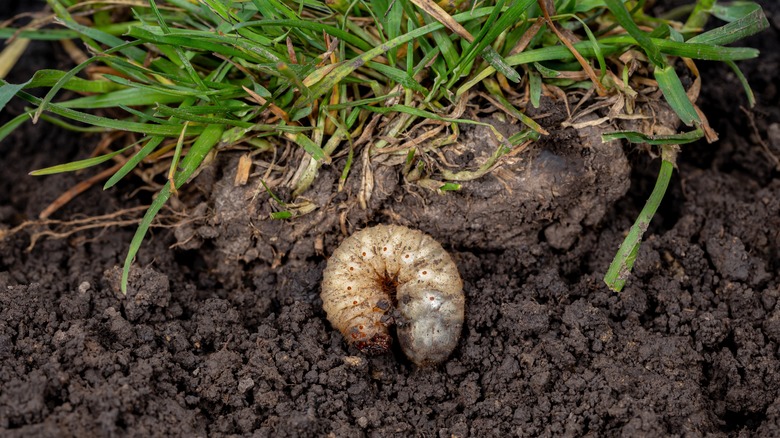
J.J. Gouin/Shutterstock
Lawns take up a great deal of your property, and since they are outdoors, they’re also exposed to the natural elements. Unfortunately, no matter how well you care for your expansive turf system, it’s always at risk of a potential pest infestation. When these pests move in, they feed on plant leaves and suck up their sustenance, leaving only a husk behind. In some cases, the creature may even feed on the roots, destroying the very foundation of your grass. This weakens plants to where they can no longer grow and sometimes completely die, for without their leaves or roots they cannot photosynthesize and survive.
Grubs, chinch bugs, and various worm species are just a few of the pests you can find writhing in your grasses. These insects are found above and below ground, and they usually have short lifecycles, from a couple of weeks to months. These short lifespans mean the bugs lay eggs and reproduce quickly, making it important to take action as soon as possible.
Unfortunately, if you prefer all-natural pest control methods, this may not be a fight you can win. Most lawn pests must be treated with insecticide sprays, granules, and concentrated liquids. The good news is that after you apply pesticide, it continues working for months afterward, meaning you won’t need to treat your lawn often. For future reference, you can reduce the risk of infestations with a few simple tips. Keep your lawn clear of debris, which insects actively seek shelter in. You should also avoid overwatering, which creates a damp environment that many grubs and worms find favorable.



